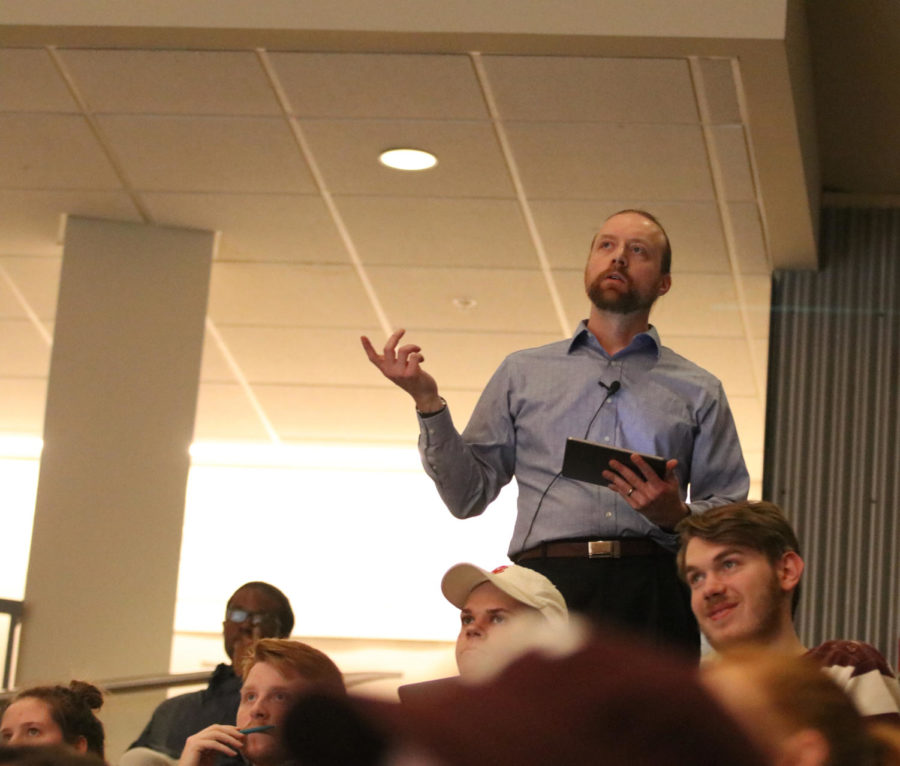New climate technology for an uncertain future
Alexandra Kelly/Iowa State Daily
Dr. Travis Franck interacting with students during his lecture. On Mon. 20 Dr. Travis Franck, of Climate Interactive, held a lecture on the topic of climate change; the lecture was held in the Kocimski Auditorium within the School of Design. This was the second lecture in the ‘Changing Change’ lecture series. Franck discussed many topics/solutions around climate change, including the predicted Global Greenhouse Gas Emissions that will cause the global temperature will rise substantially above the goal of only a 2 degrees fahrenheit increase by 2100. Franck interacted with the audience by carrying around an iPad and allowing participants to draw a line that represents how much emissions need to decrease to meet the goal. This hands on demonstration is a tool developed by Climate Interaction that Franck and his team have been using for years to help people understand climate change first hand. With the help of these free tools, Climate Interactive has held 530 events in 64 countries with over 30,646 participants. At the end of his lecture Franck held an open session for questions and discussion.
February 20, 2017
Travis Franck, program director for the non-profit organization Climate Interactive, shared during a lecture Monday innovative, real-time learning tools he and his colleagues created.
Franck is an ISU alumnus with a doctorate in engineering systems from MIT. He has attended United Nations climate change meetings around the world for the past decade.
He helped create tools to illustrate scientific principles to the non-scientist. He said that when it comes to climate change, “experiential learning” resonates with people more than traditional learning techniques.
Franck and Climate Interactive offer mediums to see how local, national and international policies can change the real world.
The technology puts users in the position of international policy makers around the world. It then simulates a future with their decided policies implemented globally. This allows people to truly understand the depth of the climate situation.
“Most people who understand we want temperature to stabilize think that means CO2 emissions need to stabilize,” Franck said. “But that’s not how the climate system works.”
Climate Interactive’s technology offers immediate confirmation or denial of climate policies so UN negotiators can immediately understand which plans are effective and which plans are not.
Audience members asked how climate policies might have some negative, unknown future side effects.
“There are no unknown side effects,” Franck said. “There are only effects that weren’t considered.”
Climate Interactive encourages group engagement, fostering communication among people from all walks of life to ensure the best possible outcome for everybody.
Mostly, people were curious about how substantial change can be brought about.
“Having conversations is important,” Franck said. He insisted that personal changes, such as adding solar panels to your house, can encourage change from others in a profound way.
Climate Interactive follows a unique learning model that encourages group engagement. More than 30,000 participants in 64 countries have used the learning tools offered by Climate Interactive to educate them about the climate.
“We need to act now,” Franck said.
Climate Interactive offers scientific answers on a moments notice to anyone who wants to ask them. Schools, churches and any community group interested in meaningful climate change policies can access these tools for free on Climate Interactive’s website.
Franck said people need to focus on creating solutions that solve the most problems. He calls this concept “multisolving.”
For instance, community gardens and electric cars are both effective ways to reduce CO2 emissions, but the community garden may solve more problems at once — food, air and water, community involvement — than electronic vehicles, so that issue should have prominence.
To learn more about climate change, or to use Climate Interactive’s learning technology, visit www.climateinteractive.org.







